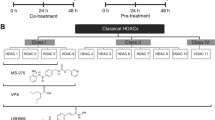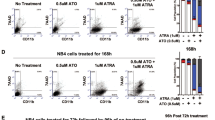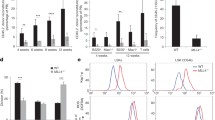Abstract
Myeloid cell differentiation is the process by which stem cells develop into mature monocytes or granulocytes. This process is achieved by the sequential activation of variety of genes. Disruption of this process can result in immunodeficiency, bone marrow failure syndrome, or leukemia. Acute promyelocytic leukemia (APL) is characterized by the t(15;17) translocation and can be treated by a combination of all-trans retinoic acid (ATRA) and anthracycline. This treatment can induce leukemic cell differentiation, leading to extremely high remission rates. XAB2, a molecule involved in nucleotide excision repair (NER), is downregulated during granulocyte differentiation and shows reduced expression in NB4 APL-derived cells in vitro. Differentiation of APL by ATRA treatment reduced XAB2 expression levels in vivo. These observations suggest that cellular differentiation is associated with reduced NER activity and provides new insights into combined differentiation induction. NB4 cells were more susceptible than the immature myeloid leukemic cell lines, Kasumi-3 and Kasumi-1, to the DNA interstrand crosslinking agent cisplatin.





Similar content being viewed by others
References
Owen C, Barnett M, Fitzgibbon J. Familial myelodysplasia and acute myeloid leukaemia–a review. Br J Haematol. 2008;1402:123–32.
Reckzeh K, Cammenga J. Molecular mechanisms underlying deregulation of C/EBPalpha in acute myeloid leukemia. Int J Hematol. 2010;914:557–68.
Ichikawa M, Yoshimi A, Nakagawa M, Nishimoto N, Watanabe-Okochi N, Kurokawa M. A role for RUNX1 in hematopoiesis and myeloid leukemia. Int J Hematol. 2013;976:726–34.
de The H, Chen Z. Acute promyelocytic leukaemia: novel insights into the mechanisms of cure. Nat Rev Cancer. 2010;1011:775–83.
Miranda MB, Johnson DE. Signal transduction pathways that contribute to myeloid differentiation. Leukemia. 2007;217:1363–77.
Nakatsu Y, Asahina H, Citterio E, Rademakers S, Vermeulen W, Kamiuchi S, et al. XAB2, a novel tetratricopeptide repeat protein involved in transcription-coupled DNA repair and transcription. J Biol Chem. 2000;27545:34931–7.
Kuraoka I, Ito S, Wada T, Hayashida M, Lee L, Saijo M, et al. Isolation of XAB2 complex involved in pre-mRNA splicing, transcription, and transcription-coupled repair. J Biol Chem. 2008;2832:940–50.
Ohnuma-Ishikawa K, Morio T, Yamada T, Sugawara Y, Ono M, Nagasawa M, et al. Knockdown of XAB2 enhances all-trans retinoic acid-induced cellular differentiation in all-trans retinoic acid-sensitive and -resistant cancer cells. Cancer Res. 2007;673:1019–29.
Takahashi Y, Endo Y, Sugiyama Y, Inoue S, Iijima M, Tomita Y, et al. XPA gene mutations resulting in subtle truncation of protein in xeroderma pigmentosum group A patients with mild skin symptoms. J Invest Dermatol. 2010;13010:2481–8.
Shiba N, Ichikawa H, Taki T, Park MJ, Jo A, Mitani S, et al. NUP98-NSD1 gene fusion and its related gene expression signature are strongly associated with a poor prognosis in pediatric acute myeloid leukemia. Genes Chromosom Cancer. 2013;527:683–93.
Enoiu M, Jiricny J, Scharer OD. Repair of cisplatin-induced DNA interstrand crosslinks by a replication-independent pathway involving transcription-coupled repair and translesion synthesis. Nucleic Acids Res. 2012;4018:8953–64.
Goodarzi AA, Noon AT, Deckbar D, Ziv Y, Shiloh Y, Lobrich M, et al. ATM signaling facilitates repair of DNA double-strand breaks associated with heterochromatin. Mol Cell. 2008;312:167–77.
Palomera-Sanchez Z, Zurita M. Open, repair and close again: chromatin dynamics and the response to UV-induced DNA damage. DNA Repair. 2011;102:119–25.
Grigoryev SA, Bulynko YA, Popova EY. The end adjusts the means: heterochromatin remodelling during terminal cell differentiation. Chromosome Res: Int J Mol Supramol Evolut Asp Chromosome Biol. 2006;141:53–69.
Lukasova E, Koristek Z, Klabusay M, Ondrej V, Grigoryev S, Bacikova A, et al. Granulocyte maturation determines ability to release chromatin NETs and loss of DNA damage response; these properties are absent in immature AML granulocytes. Biochim Biophys Acta. 2013;18333:767–79.
Nouspikel T, Hanawalt PC. Terminally differentiated human neurons repair transcribed genes but display attenuated global DNA repair and modulation of repair gene expression. Mol Cell Biol. 2000;205:1562–70.
Nouspikel T. DNA repair in differentiated cells: some new answers to old questions. Neuroscience. 2007;1454:1213–21.
Farzaneh F, Feon S, Lebby RA, Brill D, David JC, Shall S. DNA repair in human promyelocytic cell line, HL-60. Nucleic Acids Res. 1987;158:3503–13.
Nakamaki T, Ajiri T, Sakashita A, Tomoyasu S, Tsuruoka N. UV-induced DNA repair in leukemic cell differentiation. Nihon Ketsueki Gakkai zasshi: J Jpn Haematol Soc. 1989;526:977–87.
Hsu PH, Hanawalt PC, Nouspikel T. Nucleotide excision repair phenotype of human acute myeloid leukemia cell lines at various stages of differentiation. Mutat Res. 2007;6141–2:3–15.
Li J, Zhu H, Hu J, Mi J, Chen S, Chen Z, et al. Progress in the treatment of acute promyelocytic leukemia: optimization and obstruction. Int J Hematol. 2014;100:38–50.
Acknowledgments
This work was supported by Grant-in-Aid for Scientific Research, The Ministry of Education, Culture, Sports, Science and Technology (MEXT) 25461580.
Conflict of interest
The authors declare no competing financial interests.
Author information
Authors and Affiliations
Corresponding author
About this article
Cite this article
Aoki, Y., Sato, A., Mizutani, S. et al. Hematopoietic myeloid cell differentiation diminishes nucleotide excision repair. Int J Hematol 100, 260–265 (2014). https://doi.org/10.1007/s12185-014-1625-8
Received:
Revised:
Accepted:
Published:
Issue Date:
DOI: https://doi.org/10.1007/s12185-014-1625-8




